Primary Transition: Numbered Transition Offense
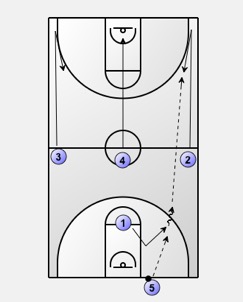
The Numbered Transition Offense is a simple Primary Transition Play that allows different variations with players able to make reads on the run and adjust to the many scenarios on the floor. Many teams run different options around this principle, and the strength behind this play is the ability to change the placement of players to work towards the strengths of specific individuals.
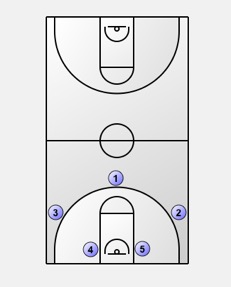
The numbered transition offense links each of the five players on the floor to specific roles. In the diagram below the responsibilities have been broken down as:
One (1): Primary Ball Handler and Outlet target
Two (2): Right Hand Sideline Runner
Three (3) Left Hand Sideline Runner
Four (4): Middle Lane Runner
Five (5): Inbounder and Trailing Big
These roles will change depending on the situation that possession has been obtained through. In situations of broken play, the positions outside those of the Point Guard maybe split into simply Guards and Bigs. The benefit of this is that the players can move between different roles depending on where they find themselves on the floor in relation to the ball. This will be explained in detail later on through the exploring of the play’s options.
In an inbound situation (following a scoring our out of bounds change in possession) the roles can be structured to mirror those identified.
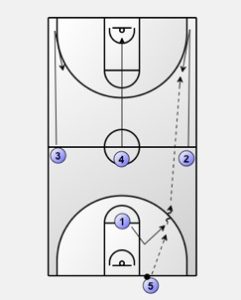
Five (5) will take the ball out of bounds and look to initiate the Numbered Transition Offense by passing to One (1).
One (1) will look to move the ball quickly up the floor by attempting to execute the push pass to Two (2) within one dribble of catching the ball on the outlet.
Two (2) and Three (3) will sprint ahead along the sidelines and look to extend the defense by taking the defenders low to in line with the basketball hoop, before bouncing to come back to the ball. This will flatten out the defense and provide a lead away from the desired catching areas for the offense to be initiated in the front court.
Four (4) in this situation runs the floor and establishes good positioning at the front of the rim looking to create early keyway offense.
The set-up for the players in the backcourt will depend on where it is desired that they fill to.
If the set-up is to be 4 Out and 1 In; then One (1) will fill to the elbow extended position on the strong side of the floor. Five (5) will trail into the weak side elbow extended position.
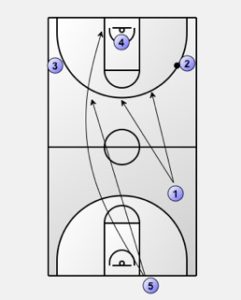
If the set-up is to be 3 Out and 2 In; then One (1) will fill to the middle of the floor and into the point position. Five (5) will still trail, with a wider arching run curling into the weak side low post position.
In a broken play situation (defensive rebound or turn-over) the strength in the numbered transition offense is grouping players to be reactive to what happens on the floor when out and running.
In the situation diagrammed below the rebounding orientation is reversed with Four (4) being the rebounder and so would become the trailing big. This would see Five (5) then run the floor and establish a position on the front of the basketball hoop.
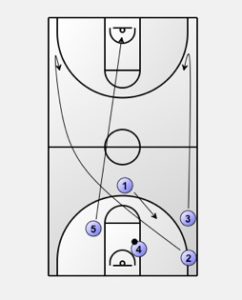
In this scenario, the sideline running guards (Two and Three) find themselves on the same side of the floor. The guard that is closest to the halfway line will maintain this running lane. Three (3) will continue to run down the closest sideline to help fast break and speed up the progression of the ball into the front court and attacking the basket.
The guard who is trailing (Two) will then fill into the role of finding the opposite side of the floor. This is because this player will see there is another guard in this lane easiest, so will then be able to make the read and change their running line while still progressing up the floor quickly.
By having players not think of themselves as numbers, but in groupings, the numbered transition offense becomes more flexible and dynamic in still achieving the desired offensive roles needed.


Thank you for laying out this transition concept. It is a good starting point.
It seems to me that this setup would be more efficient if (1) was immediately looking to pass the ball upcourt to whoever is open, (2) or (3) probably. It is unlikely that they would both (2 & 3) be in the far corner (as diagrammed) by the time the outlet pass is made so it might involve a two-pass process. I instruct my teams to USE THE PASS instead of the dribble to advance the ball up the court faster. I also have them attack the basket to get a layup first and kick out for a 3 pointer only if the layup is blocked by defense.
I will be writing a series about Speed Basketball on my blog, Building a Winning Mindset with Coach Wheeler, if you are interested in more ways to speed up the tempo of your game!